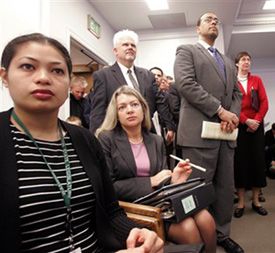When correctional professionals talk candidly about their work, the public becomes an ally.
Back in the 1990s, I did a presentation for a local 4H group along with our village police chief. As I stood there in my uniform with my badge, flashlight, glove pouch and handcuffs on my duty belt, an 8-year-old boy, looking puzzled, crinkled his face and asked me, “Where is your gun?” I told him that I didn’t carry a gun while on duty. He gave me a funny look and asked, “Well where is your stick?” I quietly told him I didn’t carry a baton on duty either.
 The most difficult tasks corrections professional undertake don’t necessarily happen inside the walls; the biggest challenge can be educating the general public, friends, family and legislators to the realities of working in a correctional institution. (AP Photo/Elaine Thompson) |
The boy was now befuddled. He waited a minute before asking, “Well if you don’t carry a gun or a stick, how do you protect yourself from the bad guys?” I simply answered by pointing to my mouth and said, “I use this,” to which he quickly responded, “What do you do, bite them?”
Everyone in the room laughed, but this young boy was very serious.
All of his perceptions of prisons and jails were based on the violent connotation that goes with our job. In his mind, we had to shoot bad guys to control them, hit them with a baton to control them — or bite them to control them.
As best I could, I explained that my job as an officer is to generate voluntary compliance through the use of my verbal skills (a concept I learned and taught upon being made an instructor by Dr. George Thompson from the Verbal Judo Institute). I don’t think this was the answer this young man —or most of the people in that room that night— were looking for, however it proved to me then (and still to this day) that one of the most important things we need to do every day as professional correctional employees is educate the public onthe realities everyday work inside a prison or jail.
My 23 years working as a corrections professional have taught me that the most difficult tasks we undertake don’t necessarily happen inside the walls. In fact, the most difficult challenge is attmpting to educate the general public, friends, family and legislators to the realities of working in a correctional institution, and working with societal outcasts—criminals.
The “out of sight, out of mind” mentality has been fostered over the years by the public’s misconceptions. These misconceptions are generally based on their own upbringing, watching movies such as Shawshank Redemption, negative media bias and even a handful of correctional personnel embellishing on the physical and sexual violence that accompany those perceptions. Worse yet, in talking with the public, I’ve found that most people feel we do little or nothing to provide a means for inmates to make themselves better while they are incarcerated, or that we don’t prepare them for their eventual re-entry into society.
How, then, do we provide this education, and what are its true benefits?
The answer is very simple. Corrections professionals need to take it upon ourselves to give the public accurate, non-defensive and non-embellished insight as to what it is like to work with offenders who are housed within the prison system. We need to be honest in telling them what we do every day, how we do our jobs and what our jobs entail.
The public needs to be informed of the services and resources made available to inmates during their incarceration. They need to know there are success stories. Society should be aware that what we do (or attempt to do) on a daily basis is the right thing, and done for the right reasons. What we do benefits and impacts society as a whole.
Another truth that must be addressed head-on is violence. At times we do deal with violent use of force situations. It’s important to acknowledge this, and to convey these incidents in an accurate and real manner.
The public wants to be educated. They want insight into what really goes on behind the fences and inside the cells. When our message is presented in an accurate and honest manner, what better resource do we have to help us accomplish our financial goals and staffing issues than an educated public?
A public that has a real understanding of what we attempt to accomplish every day is a public that will be a reliable partner in assisting us in inmate reentry and providing needed treatment and support. Meanwhile, we can assist the public in becoming less apprehensive about hiring inmates, either on work release programs or after release. Two-way communication and candor are powerful tools that need to be tapped into. Mutual aid can get help every department gear up for a progressive future.
In the past two decades, I’ve had many opportunities to speak in the community. I’ve spoken to adults and children in our schools, colleges, to civic groups, church groups, city and village boards, 4H groups — the list goes on. And though I’ve been apprehensive at times, wondering how my message would be received, I have never walked away from any of these discussions unfulfilled. I always walk away with a sense of accomplishment.











